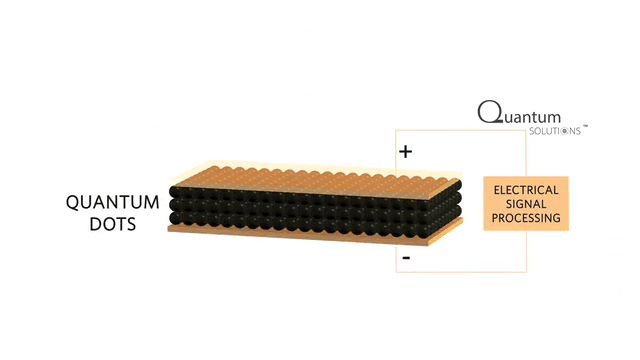Quantum Dot VIS-SWIR Cameras Enter the Market
VIS-SWIR (visible to short wave infrared) cameras are attracting enormous interest from the sensor industry. They can detect photons wavelengths both in the VIS/NIR (400-1000 nm) and SWIR (1100 – 1700 nm) spectral range. This opens up unique opportunities, because SWIR bands can be used for broader applications compared to a visible camera only. SWIR cameras are used in various application in the machine vision industry, semiconductor imaging, optical sorting e.g. food and plastic sorting, quality control of products e.g. plastic packaging defects, glass industry and defence sectors (surveillance/night vision). When imaging in SWIR, silicon is translucent which allows to see through the silicon layer to inspect or align the wafers. Additionally, colours that appear almost identical to the naked eye in the visible may be easily differentiated using SWIR.
Mass adoption of cameras that are active in both VIS and SWIR could disrupt the sensor industry, however the high price of the market-available VIS-SWIR cameras based on InGaAs and Ge keeps them from being widely adopted. Quantum dot sensing technology is a new, cost-effective, and scalable solution that can drastically reduce the cost of VIS-SWIR cameras and open up new opportunities for end users.
1. Cost-effective and scalable quantum dot technology for VIS-SWIR cameras
The image sensor industry has been developing rapidly in recent years. The emergence of new technologies promises to be very beneficial to the industry. One such innovative technology is the utilisation of colloidal quantum dots, which are defined as semiconducting nanoparticles. They can therefore give the camera extraordinary optical and electrical properties. When used in the photodetector device, they absorb both visible and short-wave infrared light and convert it into an electrical signal (Figure 1). As the amount of the generated electrical signal is proportional to the incoming light intensity, quantum dots are an excellent choice for image sensing technologies.

Market-available materials InGaAs or Ge on silicon, provide similar properties, however, the implementation process for these materials is costly, as are the InGaAs- or Ge-on-silicon based cameras themselves. Some VIS-SWIR cameras can reach $20,000-50,000. The reason for this high price is that manufacturing the cameras requires the integration of InGaAs or Ge photodetectors with a silicon CMOS read-out integrated circuit (ROIC), through a series of multistep processes with a complex hybridisation process.
Quantum dot technology, on the other hand, offers a more attractive solution. In comparison with InGaAs or Ge, colloidal quantum dots require a much simpler fabrication process. Due to inexpensive deposition techniques, QDs are easily integrable with conventional silicon integrated circuits. As a result, quantum dot technology makes it possible to mass produce VIS-SWIR cameras. This, in turn, reduces the price per VIS-SWIR sensor by 3-10x times potentially, making them much affordable for end users.
2. The first quantum dot based industrial VIS-SWIR cameras
There are several organisations that have taken this opportunity and have started applying quantum dots in VIS-SWIR cameras. Emberion is one of the pioneers in commercialisation of quantum-dot based VIS-SWIR cameras. In 2021, they introduced to the market a new product of VIS-SWIR camera based on their in house designed CMOS ROIC – Emberion VS20.
Emberion’s first generation VIS-SWIR VGA (640 x 512 pixels) camera comprises a nanomaterial based photodetector array, coupled with QDot™ quantum dots from Quantum Solutions. The QDot™ quantum dots are monolithically built onto a tailor-made CMOS ROIC and have low noise performance. One of the main advantages of this camera is its superior responsivity range. The camera is able to operate in a broad spectral range from visible (400 nm) to short-wave infrared (2000 nm) wavelengths with a high frame rate of 100 fps and high dynamic range. The next generation aims to reach 400 fps. The photodetector structure can be simplified, resulting in a lower cost and higher scalability of cameras.

Figure 2. The Emberion’s VS20 quantum dot VIS-SWIR image sensor camera.
An additional advantage of Emberion’s unique quantum dot based sensor architecture is its ability to make the image sensor to realise competitive Noise Equivalent Irradiance (NEI) performance and ultimately Signal to Noise Ratio (SNR). The dynamic range (the ratio between the photodetector signal at light and dark conditions) of the detectors is very large (120 dB full analog and 80 dB digital output range), because of the low noise and the fact that the response does not saturate. The dynamic range of the best InGaAs sensors on the other hand does not exceed 100 dB at cryogenic or thermoelectric cooled conditions.
QD based sensors meet the current demand for VIS-SWIR cameras, as they offer a broad spectral range, maximise photoelectric gain and demonstrate low noise. It is possible that this technology could potentially lead to a camera solution that would allow it to be used in a wide range of applications, apart from machine vision applications, such as mobile phones, AR glasses or VR goggles as the quantum dots allow to create smaller size pixels down to 5 µm without having to create additional complexity in the fabrication process and no TEC cooling required at all.
The Emberion’s VIS-SWIR camera provides high-performance and cost-effective solutions in a wide range of applications. Particularly those where traditional InGaAs or Ge sensors have not been able to penetrate due to cost-prohibited issues. Some of the key areas include:
- Industrial machine vision for defects identification, sorting and quality control in a variety of industries, from food quality analysis to plastics sorting.
- Autonomous vehicles for vision through fog and rain, with the situational awareness required for safety and comfort.
- Medical imaging for new diagnostic tools using SWIR spectroscopic analysis of skin and tissue, for example for cancer or bruising detection.
Images taken by the camera using the quantum dot technology for various application highlights that Emberion cameras can offer specific advantages due to its HDR (High Dynamic Range) capability. The non-linear response characteristic and the wider spectral sensitivity range of Emberion sensor offer a wider dynamic range. Comparable with the images taken by InGaAs camera (Figure 3(a)), Emberion VS20 camera (Figure 3(b)) demonstrates higher contrast differences in the objects, such as clouds, balconies and car windows.

3. Quantum Solutions – Emberion collaboration
Quantum Solutions has been collaborating with Emberion for several years. and has supported the supply of customised near-infrared QDot™ quantum dots for the successful launch of the VIS-SWIR VS20 camera.
Quantum Solutions is the partner that ensures the development, manufacturing and continuous supply of quantum dots with high optoelectronic grade quality. Colloidal quantum dots production reproducibility is one of the most crucial requirements for fabrication of industrial quantum dot VIS-SWIR cameras, in order to guarantee the replicability of the camera’s spectral range, EQE, electrical gain and processability. Quantum Solutions is able to accommodate strict requirements of the optoelectronic industry because of its unique customised approach, a proprietary manufacturing technology and high standards of quality control.
Powered with QDot™ quantum dots, Emberion VS20 camera gained a lot of interest from the image sensor industry and received a massive traction in the industrial machine vision field. With this strong start, Emberion’s future plans are to scale up the production of cost-competitive, broadband and compact VIS-SWIR cameras.
- Quantum Solutions
Quantum Solutions is a nanotechnology company and the leader in providing quantum dot materials and technology for wide range image sensors: from infrared to X-ray ranges. Their near-infrared QDot™ quantum dots have high optoelectronic grade quality and precise batch-to-batch production reproducibility, which supports the supply of materials for VIS-SWIR image sensors from small to large industrial scales. Contact at [email protected] to discuss your needs in enabling the next generation image sensors with quantum dot technology.
- Emberion
Emberion designs and produces high-performance infrared detectors for VIS-SWIR and thermal imaging targeted for night and machine vision applications. The cameras are based on our detector solution that consists of patented technologies and know-how for integration of nanomaterials and in-house designed CMOS read out integrated circuits. Emberion’s products combine high performance with competitive cost level enabling new applications. Emberion is offering evaluation cameras for various applications now. Emberion has been working on MWIR including broadband VIS-SWIR Thermal solution in order to meet industry demands. Emberion – Broaden Your Vision! www.emberion.com
Contact us at [email protected]
Acknowledgement: This article has been jointly written by Quantum Solutions & Emberion team.
